PHYSIOLOGY | IMAGES | ETYMOLOGY | TAXONOMY | GEOGRAPHY | BEHAVIOR | DIET | REPRODUCTION | ECOLOGY | CONSERVATION | FAUNAFACTS | VIDEO | SOURCES

The aardwolf is the smallest and most unique of the four extant hyaena species. Unlike other hyenas, this striped mammal is an insectivore and feeds on harvester termites, up to 300,000 in a single night. As a nocturnal creature, the aardwolf uses its relatively large ears and eyes to help it find food within the darkness of night.
Physiology
Superficially resembling the striped hyaena (Hyaena hyaena), the aardwolf has buff-yellow or dark brown fur with intermittent, dark spots or stripes covering most of its pelt: three along the body, one or two on both the fore- and hind-quarters, and several irregular, horizontal stripes on the legs. Intermittent spots or stripes may also be seen on the pale grey-white neck.
The aardwolf has a digitigrade locomotion style and the feet are usually dark solid black with irregular horizontal stripes on the legs.
The aardwolf has a thick, black mane extending from the back of the head to the tail which it erects when threatened to appear larger. During fights and chases, the aardwolf’s mane is fully erected. If only slightly disturbed, the aardwolf just fluffs out the hairs of the tail as frequently seen in cubs while playing. The coarse hairs of the aardwolf’s mane are the longest of any carnivore. The alternating black and white hairs of the aardwolf’s dorsal crest stand at about 7 centimeters (3 inches) on the back of the head, increasing to 20 centimeters (8 inches) on the shoulders, then decreasing to about 16 centimeters (6 inches) on the tail.
All aardwolves have large, pointed ears and slender skulls.
The aardwolf is slightly larger than a jackal or a fox and significantly smaller than all other hyaenas. In centimeters, total length of the aardwolf’s body is 85-105 (33-41 inches); length of tail, 20-30 (8-12 inches); height of shoulder, 45-50 (18-20 inches); length of hindfoot, 15-16 (6 inches); length of ear, 9-10 (4 inches).
There is no sexual dimorphism in body size; both male and females are roughly the same size with no striking differences in color.
Although only a quarter-half the size of other hyaenas, the aardwolf shares the distinctive sloped stature of its relatives as its forelegs are longer than its hind legs.
The most noticeable differences between aardwolves and hyaenas are in the skull and dentition as aardwolves have much slender skulls with small teeth. Whereas hyenas have a powerful dentition and are able to crush large bones, the aardwolf has a slender skull with strong jaws and canine teeth, but the cheek-teeth are reduced to small, widely spaced and irregularly numbered redundant pegs. The zygomatic arches are broad and heavily built, suggesting well-developed masseter muscles and a powerful jaw action.
Aardwolves bear a striking resemblance to striped hyenas (Hyaena hyaena). Both have similar fur texture and color, though aardwolves tend to have more regular stripes and are only a quarter the body mass of striped hyenas. Questions have been raised about this similarity as a rare form of Batesian mimicry among mammals, but no conclusive evidence is recognized.
The record lifespan for an aardwolf is 18 years 11 months. The oldest aardwolf was kept in captivity at the Frankfurt Zoo.

SEXUAL DIMORPHISM
NoneSHOULDER HEIGHT
40-50 cm. / 16-20 in.BODY LENGTH
55-105 cm. / 22-41 in.EAR LENGTH
9-10 cm. / 4 in.HINDFOOT LENGTH
15-16 cm. / 6 in.TAIL LENGTH
20-30 cm. / 8-12 in.BODY MASS
7-12 kg. / 15-26 lb.DENTAL FORMULA
I 3/3, C1/1, P 3/2-1, M 1/1-2LIFESPAN
8-20 YearsGENERATION LENGTH
6 YearsLOCOMOTION
Digitigrade

Images
Taxonomy
The aardwolf is the smallest of the four extant hyenas in the Hyaenidae family. Other species include the spotted hyaena (Crocuta crocuta), the brown hyaena (Brunnea hyaena), and the striped hyaena (Hyaena hyaena).
The aardwolf is currently generally classified as a member of the Hyaenidae family, but was formerly placed in its own family Protelidae. Scientists once thought the aardwolf merely superficially resembled the striped hyena, but recent studies now suggest that the aardwolf is a relative of the hyenas that evolved from the rest of the hyena family early on. Fossil records and genetic studies disagree upon how early the aardwolf branched from the other hyena species by about 10 million years.
The aardwolf is the only surviving species in the subfamily Protelinae, but there is debate as to whether the species is monotypic or can be divided into subspecies. Because of its disjunct distribution in Africa, occurring in two discrete areas 1,500 kilometers apart from one another, the aardwolf is generally categorized into two separate subspecies, the South African aardwolf (Proteles cristata cristata) and Northeast African aardwolf (Proteles cristata septentrionalis).
KINGDOM
AnimaliaPHYLUM
ChordataCLASS
MammaliaORDER
CarnivoraFAMILY
HyaenidaeGENUS
ProtégésSPECIES
CrostataSUBSPECIES (2)
P. c. cristata (South African), P. c. septentrionalis (Northeast African)
Etymology
The aardwolf’s common name means earth-wolf in Afrikaans and Dutch. It is also called maanhaar-jackal, Afrikaans for mane-jackal, or civet hyena, based on its habit of secreting substances from its anal gland, a characteristic shared with the African civet.
The aardwolf’s scientific name is Proteles cristata, originating from Greek and Latin. Proteles, comes from the Greek words protos and teleos, meaning complete in front, based on the fact that the aardwolf has five toes on its front feet and four on the rear, unlike other members of the Hyaenidae family. Aside from aardwolves, other hyaenas lack the pollex on the front foot and only have four digits on all four of their feet. The specific name, cristata, derives from the Latin word cristatus, meaning provided with a comb, and references the thick mane running from the back of the aardwolf’s head to the base of its fluffy tail.
GROUP
Cackle, Clan, Pack, RoutYOUNG
Cub, Pup
Region
The aardwolf is endemic to the continent of Africa and its distribution is largely determined by the location of its principle food source, Trinervitermes.Because of its disjunct distribution in Africa, occurring in two discrete areas 1,500 kilometers apart from one another, the aardwolf is generally categorized into two separate subspecies.The northern subspecies extends from central Tanzania to northeastern Uganda, Ethiopia, and Somalia. It can also be found along a narrow strip of coast along Eritrea and Sudan to extreme southeastern Egypt, located in the Sudan Government Administration Area. Further research is needed to confirm the aardwolf’s presence in Djibouti. Mbatwa in the Udzungwa Mountains of Tanzania is probably the most southerly the northern subspecies may reside.
The southern subspecies of the aardwolf ranges over most of southern Africa, extending just into southwest Angola, southern Zambia, (south of the Kafue River), and south-west Mozambique. It is entirely absent from Malawi, southern Tanzania, and most of Zambia, and have not been recorded from Lesotho.
Because its distribution appears to be related to the area’s ancient climatic history, the aardwolf is considered one of the indicator species for the Somalia-Kalahari semidesert axis of Africa. These two areas were once joined in drier periods but are now separated by wetter woodlands in Zambia.
EXTINCT
Angola, Botswana, Egypt, Eritrea, Eswatini, Ethiopia, Kenya, Mozambique, Namibia, Somalia, South Africa, South Sudan, Sudan, Tanzania, Uganda, Zambia, ZimbabweUNCERTAIN
Djibouti, Lesotho
Habitat
The aardwolf’s prime habitat is open, grassy plains as they are entirely absent from forests or pure desert. In southern Africa, the aardwolf occupies diverse habitats ranging from the karroid habitats of the Western Cape and Eastern Cape, the grasslands and scrub of Botswana, the open savanna woodlands of Zimbabwe, and the inland gravel plains of the Namib Desert in Namibia. Aardwolves may also favor farms with good populations of termites, but must be wary of persecution by farmers.
Aardwolves have been recorded at 2,000 meters above sea level in Ethiopia.
SAVANNA
DrySHRUBLAND
Subtropical/Tropical Dry, Subtropical/Tropical Moist, Shrubby VegetationGRASSLAND
Temperate, Subtropical/Tropical Dry
Co-Habitants

Black-Backed Jackal 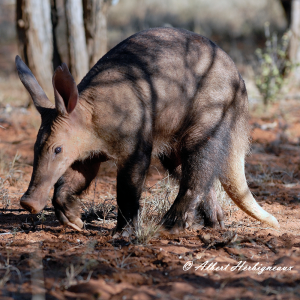
Aardvark 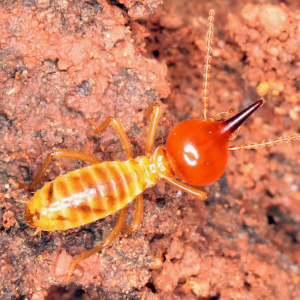
Snouted Harvester Termite 
Snouted Harvester Termite 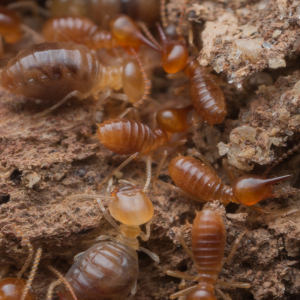
Snouted Harvester Termite 
Spring Hare 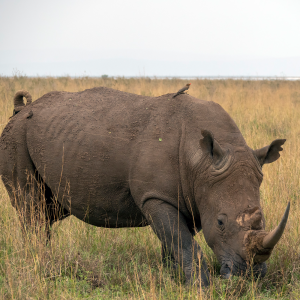
White Rhino 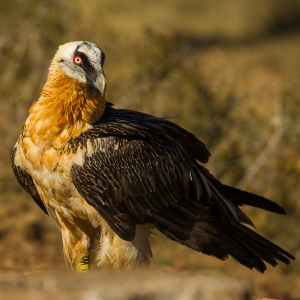
Bearded Vulture
Behavior
The aardwolf is primarily nocturnal as its activity is determined by the activity of the termites it eats; Trinervitermes trinervoides cannot tolerate direct sunlight and is therefore almost entirely active at night.
Aardwolves are socially monogamous and family oriented, with males and females living together in a territory. Mated aardwolf pairs generally occupy the same perennial territory together with their most recent offspring. Even within mated pairs, though, individual aardwolves forage away from one another. The un-weaned young are the only individuals that will be tolerated to accompany an adult when foraging, but even four-month-old cubs spend most of the night foraging alone.
CIRCADIAN RHYTHM
NocturnalMOVEMENT PATTERN
Non-Migrant
Diet
Despite its relatedness to the hyaenids, the aardwolf is one of only 18 species of the over 4,000 living mammal species that feed exclusively on termites and is one of the few true mammalian myrmecophages. Aardwolves help control termite populations as a single aardwolf can consume as many as 300,000 termites in a single night and up to 105,000,000 within a year.
Throughout its distribution, the aardwolf has been recorded to feed primarily on nasute snouted harvester termites (genus Trinervitermes). In any particular region, the aardwolf may feed mainly on one spcecies, mainly Trinervitermes bettonianus in East Africa, Trinervitermes rhodesiensis in Zimbabwe and Botswana, and Trinervitermes trinervoides in South Africa.
Unlike most other ant- or termite-eating mammals, which have to dig to access their prey, the aardwolf licks termites from the soil surface using its broad, sticky tongue. The aardwolf’s tongue is covered in large, conical papillae, and the large submaxillary glands produce copious amounts of sticky saliva.
The mandibular salivary glands of the aardwolf are also adapted for its insectivorous diet and are twice the size of the glands of a similar-sized dog. The large glands are serous and mucous secreting, while the parotid, sublingual, and zygomatic glands are serous and mixed. The mucous secretions provide a relatively thick and sticky substrate and facilitate the licking up of termites. In addition, the mucous could provide protection for the oral cavity and oesophagous from the termites’ terpene secretions, as has been speculated to be the case in myrmecophagous elephant shrews. As such, the aardwolf is tolerant of the noxious secretions of the soldier termites it feeds on. It is not known whether the saliva may play a role in the detoxification of the terpene secretions in a similar fashion to the tannin-binding proteins found in the saliva of browsing ruminants.
Aardwolves are largely independent of water, except during prolonged cold spells, satisfying their moisture requirements from termites.
PREFERENCE
SpecialistSTYLE
Forager
Prey

Snouted Harvester Termite 
Snouted Harvester Termite 
Snouted Harvester Termite
Reproduction
Aardwolf mating occurs in Summer, during the last two weeks of June and the first two weeks of July.
Although the aardwolf is socially monogamous and mated aardwolf pairs occupy the same perennial territory together with their most recent offspring, copulations are not necessarily exclusive within the pair. Extra-pair copulations regularly occur between the most aggressive males and females of less aggressive neighbors in a polygynous fashion. Males are extremely territorial over both land and mates, in and out of mating season and will not necessarily remain monogamous. Aggressive males are known to regularly copulate with neighboring females already mated with weaker mates, and litters may be fathered by more than one male.
Like other hyaenids, scent pasting with anal gland secretions by both males and females is used to attract partners and mark territories. When scent-marking, aardwolves first straddle a grass stalk, then rapidly squat while wiping a smear of secretion, approximately six millimeters in length, onto the grass. They excrete a yellowish-orange secretion from the anal gland that turns black with oxidation upon exposure to the atmosphere. Both sexes scent-mark, although males mark more frequently than females, pasting on average more than two times per 100 meters.
In the Summer, after a gestation of approximately 90 days after fertilization, female aardwolves give birth to two to five cubs.
Aardwolf cubs remain solely underground in a den, often an old aardvark (Orycteropus afer), porcupine, or spring hare (Pedetes capensis) burrow, for the first month. Most aardwolf dens are oval-shaped, about 32 centimeters high and 42 centimeters wide at the single entrance and rapidly narrowing to about 20 by 30 centimeters inside the tunnel. Dens are sought for refuge during the day and are regularly slept in for six-eight weeks at a time before another den is used, though a den may be re-occupied 6-18 months later.
Males and female aardwolves care for their young through the first, juvenile year. While the pups are still small, males invest most of their energy in guarding the den against black-backed jackals (Canis mesomelas) while females leave to forage. Guarding is necessary for aardwolf cub survival, but males only guard cubs if some are his offspring.
After their first month, aardwolf cubs continue to increase their foraging distance from the den every couple of months (with parental supervision). Weaning is usually completed by four months of age, and solitary foraging begins around seven months old. Aardwolf pups remain under parental supervision up to one year old.
At about one year old, when the next year’s cubs have emerged from the den, aardwolf offspring start making excursions into neighboring territories. Once they have finally left, they seldom return, becoming transients in search of vacant territories elsewhere in the region. If an aardwolf parent dies, however, a cub of the same sex usually remains in its natal territory.
BREEDING SEASON
June-JulyBREEDING INTERVAL
1 YearESTROUS CYCLE
14 DaysPARENTAL INVESTMENT
Maternal, PaternalGESTATION
89-92 DaysBIRTHING SEASON
Rainy SeasonLITTER
2-5MAMMAE
4WEANING
3-4 MonthsINDEPENDENCE
1 YearSEXUAL MATURITY
1.5-2 Years
Ecology
Aardwolf density and foraging techniques have noninvasive impacts on the ecosystem.
Aardwolves significantly limit termite populations throughout their range, preventing extensive wood damage for both humans and natural habitats.
Aardwolves and brown hyenas (Hyaena brunnea) are the only known hosts of two subspecies of mallophagous louse, Felicola intermedius intermedius and Felicola intermedius hyaenae. Aardwolves may also carry the parasite Haemaphysalis zumpti, a tick that favors small burrowing mammals.
The black-backed jackal (Canis mesomelas) is the aardwolf’s greatest natural enemy. Aardwolves frequently have aggressive territorial disputes with the canines and chase the jackals from their breeding dens. The use of the aardwolf’s canines for fighting is clearly reflected in their wear, as in old animals they are broken down to rounded stumps.
MEDICINE
LocalFOOD
Local
Predators

Dog 
Black-Backed Jackal 
Human
Conservation
The aardwolf is listed as Least Concern on the International Union for Conservation of Nature (IUCN) Red List of Threatened Species as it is reasonably widespread, present in numerous protected areas, and is not in peril from any major threats or range-wide declines.
Population
Although aardwolves have a generally wide and stable distribution across Africa, they are considered rare within their range.
FRAGMENTATION
Not Fragmented
THREATS
In South Africa, aardwolves have been persecuted by farmers for the mistaken belief that they predate on livestock, chickens, and eggs. These reports have not been substantiated by studies of aardwolf gut or fecal contents, however as aardwolves feed primarily on termites. The mistake probably results from mistaken identity with hyaenas or jackals. Fortunately, this perception mainly remains in the past and most farmers actively help conserve aardwolves. Unfortunately, though, aardwolves are the occasional victims of problem animal control operations, especially those using gin traps.
Urbanization and agricultural expansion may be leading to habitat loss and thus having a negative impact upon aardwolves. Some South African farmers destroy termitaria using a plough or poisons and use toxins for locust control. Areas that have been infected with insecticides then become unsuitable for aardwolves.
Additional mortality factors for aardwolves include predation by other carnivores, such as jackals and packs of dogs intended to hunt jackals and foxes, and accidental road casualties as the animals fail to avoid oncoming vehicles at night.
RESIDENTIAL & COMMERCIAL DEVELOPMENT
Housing & Urban Areas, Commercial & Industrial AreasAGRICULTURE & AQUACULTURE
Annual & Perennial Non-Timber CropsBIOLOGICAL RESOURCE USE
Hunting & Trapping Terrestrial Animals
ACTIONS
Aardwolves are present in numerous well-managed protected areas across their range.
Grassland burning and livestock overgrazing result in a gross increase in the population of Trinervitermes, so aardwolves benefit in areas where management strategies favor these conditions.
The aardwolf population in Botswana is listed on CITES Appendix III.
FaunaFacts
Video
SourceS
- Aardwolf. (2018). In The Random House Dictionary. Random House, Inc.
- Aardwolf. (2017, November 23). In Wikipedia.
- Aardwolf. (2012). In Collins English Dictionary – Complete & Unabridged 2012 Digital Edition. William Collins Sons & Co. Ltd.
- Aardwolf. The Animal Files.
- Aardwolf. Animal Spot.
- Aardwolf. Convention on International Trade in Endangered Species of Wild Fauna and Flora (CITES).
- Aardwolf. Etosha National Park.
- Aardwolf. In Merriam-Webster. Merriam-Webster, Inc.
- Aardwolf. Institute for Wildlife Studies.
- Aardwolf. Mpala Live!
- Aardwolf: Proteles cristatus. Cincinnati Zoo & Botnaical Garden.
- Aardwolf – Termite eating den dweller. FactZoo.
- Anderson, M. D. (1989). Aardwolf (Letter to journal). African Wildlife, 43(1), 50-51.• (1991). Oranjejag (Letter to journal). African Wildlife, 45, 268.
- (1992). Anteating chats feeding in association with aardwolves. Ostrich, 63, 186.
- (1994). The influence of seasonality and quality of diet on the metabolism of the aardwolf, Proteles cristatus (Sparrman 1783) (Master’s thesis). University of Pretoria, Pretoria, South Africa.
- (2004). Aardwolf adaptations: A review. Transactions of the Royal Society of South Africa, 59(2), 99-104.
- (2006). Aardwolf Proteles cristatus. In J. Kingdon (Ed.), Collins Field Guide: Mammals of Africa. Harper Collins.
- Anderson, M. D. & Richardson, P. R. K. (1992). Remote immobilization of the aardwolf. South African Journal of Wildlife Research, 22(1), 26-28.
- Anderson, M. D., Richardson, P. R. K., & Woodall, P. F. (1992, November). A functional analysis of the feeding apparatus and digestive tract anatomy of the aardwolf, Proteles cristatus. Journal of Zoology of London, 228(3), 423-434.
- Anderson, M. D., Williams, J. B., & Richardson, P. R. K. (1997, July/August). Laboratory metabolism and evaporative water loss of the aardwolf, Proteles cristatus. Physiological Zoology, 70, 464-469.
- Anonymous. (2009, Nocember 5). Aardwolf (Proteles cristatus). WildlifeRanching.
- Apps, P. J., Viljoen, H. W., Richardson, P. R. K, & Pretorius, V. (1989, May). Volatile components of anal gland secretion of aardwolf ( Proteles cristatus ). Journal of Chemical Ecology, 15(5), 1681-1688.
- Bothma, J. Du P. (1971). Notes on the movement by the black-backed jackal and the aardwolf in the western Transvaal. Zoologica Africana, 6(2), 205-207.
- Bothma, J. Du P. & Nel, A. J. A. (1980). Winter food and the foraging behaviour of the aardwolf Proteles cristatus in the Namib-Naukluft Park. Madoqua, 12(3), 141-149.
- Bothma, J. Du P., Nel, A. J. A., & Macdonald, A. (1984). Food niche separation between four sympatric Namib desert carnivores. Journal of Zoology of London, 202(3), 327-340.
- Brekelmans, W. (2011). Sex differences in home range size, scent mark rates, and hormons in the aardwolf (Proteles cristatus).
- Cillie, B. (2011). Pocket photoguide to mammals of southern African (5th ed.). Cape Town, South Africa: Sunbird Publishers. (Original work published 2006)
- Cooper, R. L. & Skinner, J. D. (1979). Importance of termites in the diet of the aardwolf Proteles cristatus in South Africa. South African Journal of Zoology, 14, 5-8.
- Dean, W. R. J. (1978). Stomach contents of a specimen of Proteles cristatus from Angola (Carnivora: Protelidae).Zoologica Africana, 13(2), 165-173.
- The Editors of Encyclopædia Britannica. (2017, April 11). Aardwolf. Encyclopædia Britannica. Encyclopædia Britannica, inc.
- Ewer, R. F. (1973). The carnivores. Ithaca, NY: Cornell University Press.
- Flower, W. H. (1869). On the anatomy of Proteles, Proteles cristatus (Sparrman). Proceedings of the Zoological Society of London, 473-496.
- Furstenburg, D. (2008, February). Aardwolf Preteles cristatus. Geo Wild Consult.
- Gilbert, F. (2010, August, 24). Aardwolf (Proteles cristata). Wildscreen Arkive.
- Gingerich, P. D. (1974, July 31). Proteles cristatus from the Pleistocene of South Africa with a note on tooth replacement in the aardwolf (Mammalia: Hyaenidae). Annals Transvaal Museum, 29(4), 49-54.
- Goodhart, C. B. (1975, December). Does the aardwolf mimic a hyena?. Zoological Journal of the Linnean Society, 57, 349-356.
- Green, D. S. (2015). Proteles cristata. The IUCN Red List of Threatened Species 2015: e.T18372A45195681.
- Hendey, Q. B. (1974, July 31). New fossil carnivores from the Swartkrans australopithecine site (Mammalia: Carnivora). Annals Transvaal Museum, 29(3), 27-48.
- Holekamp, K. E. (2007, October). Hyaena bibliography. The International Union for Conservation of Nature and Natural Resources (IUCN) Hyaena Specialist Group.
- Jirka, E. (2006, September). Creatures of the night: Aardwolf & Co. FourStripedMouse (FSM-Times), 8, 7-14.
- Kingdon, J. (1977). East African Mammals: An Atlas of Evolution in Africa: Carnivores (Vol. 3A). London: Academic Press.
- Koehler, C. E. & Richardson, P .R. K. (1990, October 23). Proteles cristatus. Mammalian Species, (363), 1-6.
- Kok, O. B. & Hewitt, P. H. (1990, January). Bird and mammal predators of the harvester termite Hodotermes mossambicus (Hagen) in semi-arid regions of South Africa. South African Journal of Science, 86(1), 34-37.
- Kratzing, J. E. & Woodall, P. F. (1988). The rostral nasal anatomy of two elephant shrews. Journal of Anatomy, 157, 135-143.
- Kruuk, H. & Sands, W. A. (1972, November). The aardwolf (Proteles cristatus, Sparrman 1783) as a predator of termites. African Journal of Ecology, 10(3), 211-227.
- Marneweck, D. G., Cameron E. Z., Ganswindt, A., & Dalerum, F. (2015, January). Behavioural and endocrine correlates to the aardwolf mating system. Mammalian Biology – Zeitschrift für Säugetierkunde, 80(1), 31-38.
- Marneweck, D. G., Ganswindt, A., Rhodes, S., Bellem, A., Bryant, J., Wielebnowski, N., & Dalerum, F. (2013). Reproductive endocrinology of zoo-housed aardwolves. Acta Therial, 58, 223-232.
- Matsebula, S. N. (2001). A study of the Aardwolf (Proteles cristata) at Malolotja Nature Reserve, Western Swaziland. Swaziland National Trust Commission.
- Matsebula, S. N., Monadjem, A., Roques, K. G., & Garcelon, D. K. (2009). The diet of the aardwolf, Proteles cristatusat Malolotja Nature Reserve, western Swaziland. African Journal of Ecology, 47, 448-451.
- Meester, C. M., Rautenbach, J. A. J., Dippenaar, I. L., & Baker, N. J. (1986, December). Classification of southern African mammals: Orders primates and carnivora . Transvaal Museum Monographs 5(1), 1-359.
- Mills, G. & Hofer, H. (1998). Status survey and conservation action plan: Hyaenas. Gland, Switzerland, & Cambridge, UK: International Union for Conservation of Nature and Natural Resources (IUCN)/SSC Hyaena Specialist Group.
- Mills, M. G. L., Nel, J. A. J., & Bothma, J. Du P. (1984). Notes on some smaller carnivores from the Kalahari Gemsbok National Park. Koedoe, 1, 221-227.
- Nel, J. A. J. & Bothma, J. Du P. (1983). Scent marking and midden use by aardwolves (Proteles cristatus) in the Namib Desert. African Journal of Ecology, 21, 25-39.
- New World Encyclopedia contributors. (2017, November 29). Aardwolf. New World Encyclopedia.
- Nowak, R. M. (2005). Walker’s Carnivores of the World. Baltimore, MD: The Johns Hopkins University Press.
- Peters, G. & Sliwa, A. (1997). Acoustic communication in the aardwolf, Proteles cristatus (Carnivora: Hyaenidae).Mammalian Biology – Zeitschrift für Säugetierkunde, 62, 219-238.
- Peirce, M. A., Anderson, M. D. & Prenzhorn, B. L. (2001, November 3). Piroplasmosis in the aardwolf (Proteles cristatus). Veterinary Record, 149, 561-562.
- Piper, R. (2007). Extraordinary animals: An encyclopedia of curious and unusual animals. Westport, CT: Greenwood Press.
- Pocock, R. I. & F. R. S. (1916). On some of the external structural characters of the striped hyaena (Hyaena hyaena) and related genera and species. The Annals and Magazine of Natural History Including Zoology, Botany, and Geology, Series 8, 17, 330-343.
- Proteles cristata: Aardwolf. Encyclopedia of Life (EOL).
- Proteles cristatus (Sparrman, 1783). Integrated Taxonomic Information System (ITIS).
- Ray, J. C., Hunter, L., & Zlgouris, J. (2005, December). Setting conservation and research priorities for larger African carnivores. Wildlife Conservation Society, 24, 105-108.
- Redford, K. H. (1987). Ants and termites as food: Patterns of mammalian myrmecophagy. In H. H. Genoways (Ed.), Current Mammalogy (Vol. 1) (pp. 349-400). New York, NY: Plenum Press.
- Richardson, P. R. K. (1985). The social behaviour and ecology of the aardwolf, Proteles cristatus (Sparrman, 1783) in relation to its food resources (Doctoral dissertation). University of Oxford, Oxford.
- (1987a). Aardwolf mating system overt cuckoldry in an apparently monogamous mammal. South African Journal Science, 83(7), 405-410.
- (1987b, October). Aardwolf: The most specialized myrmecophagous mammal? South African Journal ofScience, 83, 643-646.
- (1987c). Food consumption and seasonal variation in the diet of the aardwolf Proteles cristatus in southern Africa. Zeitschrift für Säugetierkunde, 52, 307-325.
- (1990). Scent marking and territoriality in the aardwolf. In D. W. Macdonald, D. Müller-Schwarze, & S. Natynzuk (Eds.), Chemical Signals in Vertebrates 5 (pp. 378-387). Oxford, NY: Oxford University Press.
- (1991). Territorial significance of scent marking during the non-mating Season in the aardwolf Proteles cristatus (Carnivora: Protelidae). Ethology(1-2), 87, 9-27.
- (1993). The function of scent marking in territories: A resurrection of the intimidation hypothesis. Transactions of the Royal Society of South Africa, 48(2), 195-206.
- Richardson, P. R. K. & Anderson, M. D. (1993). Chemical capture of the aardwolf Proteles cristatus. In A. A. McKenzie (Ed.), The capture and care manual: capture, care, accommodation and transportation of wild African mammals. Pretoria, South Africa: Wildlife Decision Support Services & South African Veterinary Foundation.
- Richardson, P. R. K., & Bearder, S. K. (1984). The aardwolf. In D. W. MacDonald (Ed.), The Encyclopaedia of Mammals (Vol. 1) (pp. 158-159). London: George Allen and Unwin.
- Richardson, P. R. K. & Coetzee, E. M. (1988). Mate desertion in response to female promiscuity in the socially monogamous aardwolf. South African Journal of Zoology, 23(4), 306-308.
- Richardson, P. R. K. & Levitan, C. D. (1994, February). Tolerance of aardwolves to defense secretions of Trinervitermes trinervoides. Journal of Mammalogy, 75(1), 84-91.
- Roberts, A. (1951). The Mammals of South Africa. South Africa: Central News Agency.
- Rothschild, W. (1902). Two new subspecies of Proteles. Novitates Zoologicae, 9, 443.
- Scalter, W. L., M. A., & F. Z. S. (1900). Mammals of South Africa: Primates, Carnivora, and Ungulata (Vol. 1). London: R. H. Porter.
- Skinner, J. D. & Chimimba, C. T. (2006). The mammals of the southern African subregion (3rd ed.). Cape Town, South Africa: Cambridge University Press.
- Skinner, J. D. & van Aarde, R. J. (1983). The use of space by the Aardwolf Proteles cristatus. Notes From The Mammal Society, 52, 299-301.
- Skinner, J. D. & Smithers, R. H. N. (1990). The mammals of the southern African subregion. Pretoria, South Africa: University of Pretoria.
- Sliwa, A. (1996, May). A functional analysis of scent marking and mating behaviour in the aardwolf, Proteles cristatus(Sparrman, 1783) (Doctoral dissertation). University of Pretoria, Pretoria.
- Sliwa, A. & Richardson, P.R.K. (1998, July). Responses of aardwolves ( Proteles cristatus, Sparrman 1783) to translocated scent marks. Animal Behaviour, 56(1), 137-146.
- Smithers, R. H. N. (1966). The mammals of Rhodesia, Zambia and Malawi. St. James’s Place, London: Collins.
- (1971). The mammals of Botswana. Salisbury, Rhodesia: Trustees of the National Museums of Rhodesia.
- (1986). South African red data book – terrestrial mammals: A report of the Committee for Nature Conservation Research National Programme for Ecosystem Research. Pretoria, Republic of South Africa: South African National Scientific Programmes Report No. 125.
- Smithers, R. H. N. & Lobão Tello, J. L. P. (1976). Museum Memoir; No. 8: Checklist and atlas of the mammals of Moc¸ambique. Salisbury, Rhodesia: Trustees of the National Museums and Monuments of Rhodesia.
- Sparrman, A. P. (1785). A voyage to the Cape of Good Hope, towards the Antarctic Polar Circle, and round the world: But chiefly into the country of the Hottentots and Caffres, from the year 1772, to 1776. London: G. G. J. Robinson & J. Robinson, Pater-Noster-Row.
- Spinnelli, N. (1970, January). Hand-rearing an aardwolf: Proteles cristata. International Zoo Yearbook, 10(1), 82-83.
- Stoeckelhuber, M., Sliwa, A., & Welsch, U. (2000). Histo-Physiology of the scent-marking glands of the penile pad, anal pouch, and the forefoot in the aardwolf (Proteles cristatus). The Anatomical Record, 259(3), 312-326.
- Stump, M. (2011). Proteles cristata aardwolf. Animal Diversity Web.
- Taylor, W. A. & Skinner, J. D. (2000, June). Associative feeding between Aardwolves (Proteles cristatus) and Aardvarks (Orycteropus afer). Mammal Review, 30(2), 141-143.
- Taza, V. (2003). Aardwolf. Blue Planet Biomes.
- van Jaarsveld, A. S., Richardson, P. R. K., & Anderson, M. D. (1995, June). Post-natal growth and sustained lactational effort in the aardwolf: Life-history implications. Functional Ecology, 9(3), 492-497.
- Vaughan, T. A. (1986). Mammalogy (4th ed.). Philadelphia, PA: Saunders College Publishing.
- von Ketelhodt, H. F. (1966). Der erdwolf, Proteles cristatus (Sparrman, 1783). Zeitschrift fur Saugetierkunde, 31, 300-308.
- Watson, M. (1882, October). On the muscular anatomy of Proteles as compared with that of hyeena and viverra. Proceedings of the Zoological Society of London, 50(3), 579–586.
- Wells, M. E. (1968, August). A comparison of the reproductive tracts of Crocuta crocuta, Hyaena hyaena and Proteles cristatus. East African Wildlife Journal, 6(1), 63-70.
- Wemmer, C. & Wilson, D. E. (1983). Structure and fuction of hair crests in African Carnivora. In J. F. Eisenberg & D. G. Kleiman (Eds.), Advances in the study of mammalian behavior (pp. 239-264). The American Society of Mammalogists: Special Publications, 7, 1-753.
- Williams, J. B., Anderson, M. D., & Richardson, P. R. K. (1997). Seasonal differences in field metabolism, water requirements, and foraging behavior of free-living aardwolves. South African Ecology, 78(8), 2588-2602.



































